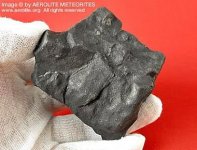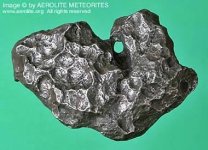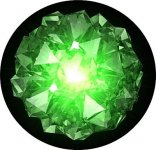Navigation
Install the app
How to install the app on iOS
Follow along with the video below to see how to install our site as a web app on your home screen.
Note: This feature may not be available in some browsers.
More options
You are using an out of date browser. It may not display this or other websites correctly.
You should upgrade or use an alternative browser.
You should upgrade or use an alternative browser.
Help identify the metal (meteorite?)
- Thread starter atom21
- Start date
What you have there looks to be iron ore slag. 
"Meteorites tend to look different from the ordinary terrestrial rocks around them. They do not contain the common earth mineral quartz, and in general do not contain vesicles. When gas escapes from cooling molten material, it creates small pinprick holes or cavities in a rock's surface. The volcanic rock pumice, often used in skin care for the removal of callouses, contains vesicles which is one of the reasons it is very light in weight. If a suspected meteorite looks like a sponge, with lots of tiny holes, it is probably volcanic rock or slag of earthly origin.
Meteorites are divided into three basic groups: irons, stones, and stony-irons. Practically all meteorites contain a significant amount of extraterrestrial iron and nickel, so the first step in identifying a possible meteorite is the magnet test. Iron and stony-iron meteorites are rich in iron, and will stick to a powerful magnet so strongly that it can be difficult to separate them! Stone meteorites also, for the most part, have a high iron content and a good magnet will happily adhere to them. Many earth rocks will also attract a magnet, so this is not a definitive test, but it's a good step in the right direction. Lunar and Martian meteorites, and most achondrites (stone meteorites without chondrules) contain little or no iron and even a powerful magnet will generally have no effect on them. Iron is heavy and most meteorites feel much heavier in the hand than an ordinary earth rock should. A softball-sized iron meteorite will likely weigh five or six pounds, making it seem unnaturally dense. Imagine holding a steel ball bearing as big as a grapefruit and you'll get the idea.
When a meteoroid (a potential meteorite) streaks through our atmosphere, tremendous heat is generated by atmospheric pressure. The surface of the rock melts and the air around it incandesces. As a result of this brief but intense heating, the surface burns and forms a thin, dark rind called fusion crust. Meteorites literally began to burn up in our atmosphere, so they tend to appear darker than the terrestrial rocks around them. Desert varnish forms on the surface of some earth rocks, particularly in arid areas, and can easily be mistaken for fusion crust by an untrained eye. True fusion crust does not occur on earth rocks. It is delicate and will weather away over time, but a freshly fallen meteorite will exhibit a rich black crust, much like a charcoal briquette."
Here are a couple of examples of real meteorites.
Dave
"Meteorites tend to look different from the ordinary terrestrial rocks around them. They do not contain the common earth mineral quartz, and in general do not contain vesicles. When gas escapes from cooling molten material, it creates small pinprick holes or cavities in a rock's surface. The volcanic rock pumice, often used in skin care for the removal of callouses, contains vesicles which is one of the reasons it is very light in weight. If a suspected meteorite looks like a sponge, with lots of tiny holes, it is probably volcanic rock or slag of earthly origin.
Meteorites are divided into three basic groups: irons, stones, and stony-irons. Practically all meteorites contain a significant amount of extraterrestrial iron and nickel, so the first step in identifying a possible meteorite is the magnet test. Iron and stony-iron meteorites are rich in iron, and will stick to a powerful magnet so strongly that it can be difficult to separate them! Stone meteorites also, for the most part, have a high iron content and a good magnet will happily adhere to them. Many earth rocks will also attract a magnet, so this is not a definitive test, but it's a good step in the right direction. Lunar and Martian meteorites, and most achondrites (stone meteorites without chondrules) contain little or no iron and even a powerful magnet will generally have no effect on them. Iron is heavy and most meteorites feel much heavier in the hand than an ordinary earth rock should. A softball-sized iron meteorite will likely weigh five or six pounds, making it seem unnaturally dense. Imagine holding a steel ball bearing as big as a grapefruit and you'll get the idea.
When a meteoroid (a potential meteorite) streaks through our atmosphere, tremendous heat is generated by atmospheric pressure. The surface of the rock melts and the air around it incandesces. As a result of this brief but intense heating, the surface burns and forms a thin, dark rind called fusion crust. Meteorites literally began to burn up in our atmosphere, so they tend to appear darker than the terrestrial rocks around them. Desert varnish forms on the surface of some earth rocks, particularly in arid areas, and can easily be mistaken for fusion crust by an untrained eye. True fusion crust does not occur on earth rocks. It is delicate and will weather away over time, but a freshly fallen meteorite will exhibit a rich black crust, much like a charcoal briquette."
Here are a couple of examples of real meteorites.

Dave
Attachments
Upvote
0
- Thread starter
- #3
What you have there looks to be iron ore slag.
Dave
Thank!
I also doubt that this is a meteorite, but I wonder what kind of metal it is.
I forgot to write that it does not respond to a magnet.
I cut a small piece of the grinder. If there were no sparks. Probably there is no iron in it. It is viscous, similar to aluminum, but heavy like lead.
Cut point does not oxidize.
Last edited:
Upvote
0
Thank!
I also doubt that this is a meteorite, but I wonder what kind of metal it is.
I forgot to write that it does not respond to a magnet.
I cut a small piece of the grinder. If there were no sparks. Probably there is no iron in it. It is viscous, similar to aluminum, but heavy like lead.
Cut point does not oxidize.
With this additional information atom, it may well be just a piece of lead.

Dave
Upvote
0
That is unlikely.
Lead in the air would be covered with an oxide film. And this metal remains brilliant. Yes, and melt it like lead, I could not.

Then it must be kryptonite?

Attachments
Upvote
0
Reanm8er
Bronze Member
- Aug 17, 2018
- 2,283
- 3,556
- Detector(s) used
- WW2 Mine Detector, 2 Garrets and an Underwater Fisher (Older Machines)
- Primary Interest:
- All Treasure Hunting
Great info ANTIQUARIAN and Odjob.
In the remote chance that this could be nickel it would be very tough but not so hard. Try filing it to see if a file will cut it. If not, or is very resistive, it may be nickel or an alloy of it.
In the remote chance that this could be nickel it would be very tough but not so hard. Try filing it to see if a file will cut it. If not, or is very resistive, it may be nickel or an alloy of it.
Upvote
0
Reanm8er
Bronze Member
- Aug 17, 2018
- 2,283
- 3,556
- Detector(s) used
- WW2 Mine Detector, 2 Garrets and an Underwater Fisher (Older Machines)
- Primary Interest:
- All Treasure Hunting
Be reluctant to try melting various metals on your cook stove. There are some metals, like magnesium that once ignited burn at extreme temperatures and cannot be extinguished with water. In fact they may explode.
Upvote
0
Top Member Reactions
-
 3680
3680 -
 1985
1985 -
 1873
1873 -
 1504
1504 -
 1243
1243 -
 1124
1124 -
 1078
1078 -
 986
986 -
 861
861 -
 739
739 -
 656
656 -
 574
574 -
 493
493 -
 466
466 -
 434
434 -
E
430
-
 395
395 -
 393
393 -
 384
384 -
 381
381
Users who are viewing this thread
Total: 2 (members: 0, guests: 2)
Latest Discussions
-
Naturallly Occuring Formation OR Manmade Treasure Marker/Sign?
- Latest: Crosse De Sign
-
-
-















